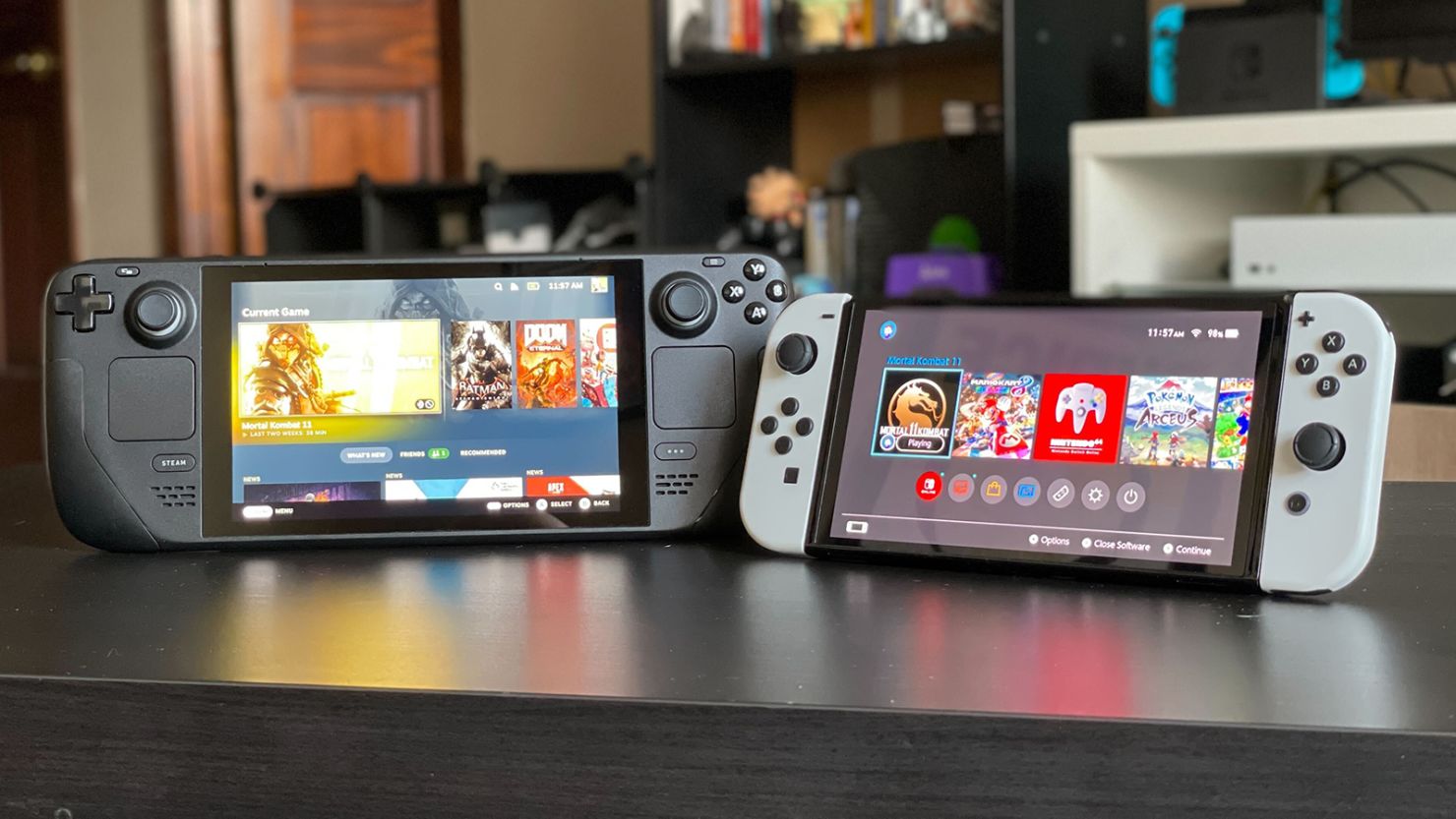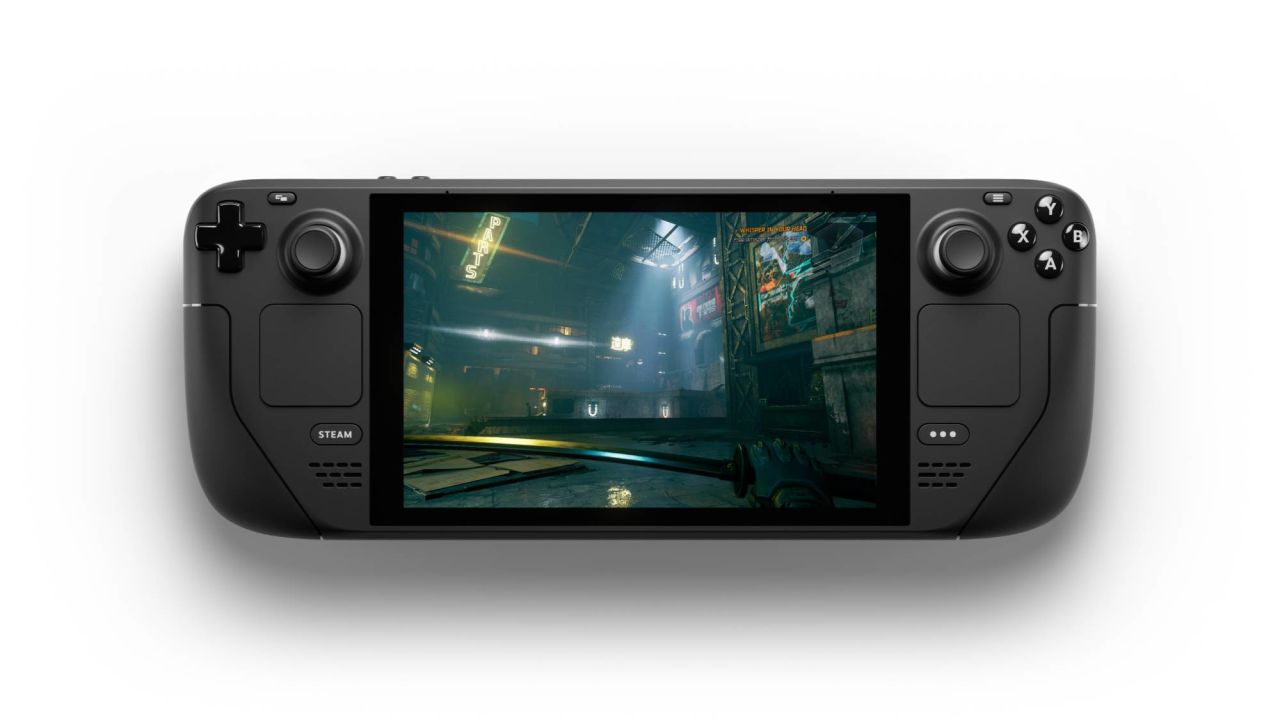This article is part of our series?Battle of the Brands, in which we compare category-leading products to their counterparts to determine which are actually worth your money.
Handheld gaming is seeing a resurgence of sorts, and Valve’s Steam Deck and the Nintendo Switch OLED have been leading the conversation for the past few years. It’s easy to see why; they’re both portable consoles that let you play a ton of different games on the go, and even have a fair amount of titles in common — from The Witcher and Skyrim to countless great indies. They’re not that far apart in starting price, and now that the Steam Deck has an optional OLED screen, the two handhelds more or less offer the same display quality.
But despite their similarities, the Steam Deck and Switch OLED are each vastly unique devices aimed at different types of gamers. Do you go with Valve’s handheld computer that offers near-limitless options or Nintendo’s versatile console that’s designed for anyone to pick up and play right out of the box?
We’ve spent many, many hours gaming on both of these compelling machines and are ready to help you pick.
Steam Deck vs. Nintendo Switch OLED at a glance
The standard Steam Deck is a great option for playing PC games on the go for a good price.
Get the Steam Deck OLED if you're willing to spend extra for a superior display and better battery life.
This is the best Nintendo Switch you can buy, ideal for those who want a simple pick-up-and-play experience or simply love Nintendo games.
Quick specs comparison
|
Valve Steam Deck
|
Valve Steam Deck OLED
|
Nintendo Switch OLED
|
|
|---|---|---|---|
| Display | 7-in., 1280 x 800 IPS LCD touchscreen, up to 60Hz |
7.4 in., 1280 x 800 HDR OLED touchscreen, up to 90Hz |
7-in., 1280 x 720 OLED touchscreen |
| Processor | Custom AMD APU |
Custom AMD APU |
Nvidia Tegra X1 |
| Storage | 64GB / 256GB / 512GB (expandable via microSD) |
512GB / 1TB (expandable via microSD) |
64GB (expandable via microSD) |
| Battery Life (rated) | 2 to 8 hours |
3 to 12 hours |
4.5 to 9 hours |
| Size and weight | 11.7 x 4.6 x 1.9 in., 1.47 lb. |
11.7 x 4.6 x 1.9, 1.4 lb. |
9.5 x 4 x .0.55 in., 0.93 lb. |
The Nintendo Switch is more portable, but the Steam Deck has more robust controls
If true portability is a concern, go with the Switch. The Switch OLED feels positively tiny compared to the Steam Deck, with a 9.5-inch-wide design that won’t take up much bag space and a comfortably lightweight frame that weighs less than a pound. The latest Nintendo Switch also has a sturdy built-in kickstand for easy tabletop play, something you won’t find on the Steam Deck.
Valve’s handheld is significantly larger and about half a pound heavier but has the advantage of curvier, more ergonomic grips that better mimic the feel of a traditional controller. And while you’ll need to make room for its extra heft, it also comes with a carrying case — something you’ll have to buy separately for your Switch. It’s worth noting that the newer Steam Deck OLED is a fraction of a pound lighter than the OG model, which is a small but welcome improvement.
When it comes to controller options and ways to play, the Switch OLED and Steam Deck are both extremely versatile. The Switch’s big calling card is its ability to, well, switch — you can play it as a traditional handheld, prop it up on a table and remove the Joy-Cons for impromptu Mario Kart sessions or dock it to a TV for a full console experience.
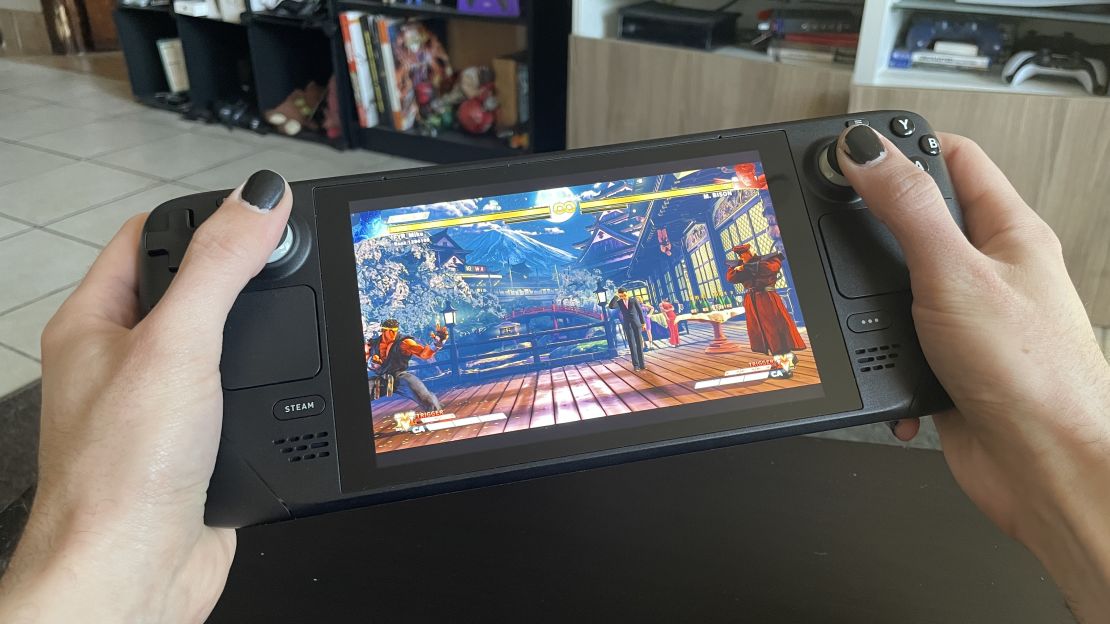
The Steam Deck can more or less do all of these things, but not out of the box. You can pair it with pretty much any Bluetooth or USB-C controller of your choosing (or even a mouse and keyboard), and you can connect it to a monitor via its USB-C port. There’s no included stand or dock for doing all of this easily, though you can pick up Valve’s Steam Deck Docking Station for an extra $79 or one of the many cheaper third-party options out there.
Both systems offer gyroscope-based motion controls, touch-capable screens and impressive haptic feedback, but only the Switch has removable controllers for easily getting some multiplayer going. On the flip side, the Steam Deck has a far more robust button layout, with all of the requisite buttons and sticks joined by two customizable trackpads and four additional buttons in the rear. Better yet, every single button, stick and pad on the Steam Deck is fully remappable on a game-by-game basis, making it easy to tailor the system to your playstyle.
Two different game libraries — with some surprising similarities
Do you care about Mario, Zelda and Pokemon, or do you want access to thousands of PC games from the past few decades? That’s the key decision you’ll make when choosing between the Switch and Steam Deck’s game libraries, though there’s a surprising amount of overlap between the two.
The Nintendo Switch is the only console of the two that lets you play Nintendo games (well, legally, at least), and some pretty great ones at that. The lineup of Switch exclusives is one of Nintendo’s best, with must-play masterpieces like The Legend of Zelda: Tears of the Kingdom, Super Mario Odyssey and Animal Crossing: New Horizons joined by multiplayer essentials like Mario Kart 8 Deluxe, Super Smash Bros. Ultimate and Splatoon 3. And if you’re feeling retro, the Switch has access to a good amount of NES, Super NES, Nintendo 64, Game Boy, Game Boy Advance and Sega Genesis games via Nintendo’s Switch Online service.
As of this writing, there are more than 12,000 games on the Switch eShop, with new ones arriving at a pretty decent clip. And considering that there’s no easy way to play Fortnite natively on Steam Deck, Nintendo’s handheld is currently the only option of the two for playing Epic’s wildly popular online shooter.

Meanwhile, the Steam Deck wins on sheer selection. The system has access to the tens of thousands of games on Valve’s popular Steam platform, ranging from modern hits like Elden Ring, God of War and Death Stranding to PC classics like Left 4 Dead 2, Counter-Strike and Splinter Cell. Not every Steam game works on Deck, but there are already well over 4,000 titles that pass Valve’s “Great on Deck” certification, and even more that are confirmed to be playable.
You can also fire up a web browser on Steam Deck to access cloud gaming services like Xbox Game Pass Ultimate and Amazon Luna, though there are still some kinks being worked out on that front. And while you’ll need a $20 per year Nintendo Switch Online subscription to play multiplayer Switch games online, Steam games can be played over the internet for free.
If indie games are your thing, you’ll have a similarly great experience with both handhelds. The Switch and Steam Deck have access to some of the best indies of the past decade-plus, including Stardew Valley, Cuphead, Hades, Among Us and Hollow Knight. These games tend to come to Steam first, but both systems have access to lots of the essentials. The Switch and Steam Deck even have a few major third-party games in common, including Minecraft, Doom Eternal, The Witcher 3, The Elder Scrolls V: Skyrim and Diablo III. However, these titles generally don’t run nearly as well on Switch as they do on PC, which brings us to our next point.
The Steam Deck wins on performance, while the Switch gets you OLED for less
The Switch has no shortage of games that look and run great — particularly the ones that come from Nintendo — but the Steam Deck is significantly more powerful when it comes to running modern blockbusters. Thanks to a custom AMD processor, Valve’s handheld can run demanding PC games at a fidelity that’s comparable to a mid-range gaming laptop, whereas the same titles are significantly compromised on the Nvidia Tegra X1-powered Switch.
This performance gap immediately became apparent when we ran Mortal Kombat 11 side-by-side on both systems. The Steam Deck rendered the game’s characters and backgrounds in sharp, cinematic detail, while the same scene looked pixelated and blurry on the Switch. It’s worth noting that both versions of the game ran at a smooth 60 frames per second, but the Switch port makes some serious sacrifices to get there. The Steam Deck also loaded up the action more than twice as fast as the Switch OLED, thanks in part to the speedy solid state drive (SSD) that you’ll get in the 256GB, 512GB and 1TB versions of the system.

The Switch’s relatively inferior performance won’t be as big a deal if you typically play lightweight games like Minecraft and Stardew Valley, and again, Nintendo titles look and run especially great on the system. But if you’re looking for the best way to play the likes of The Witcher, Apex Legends or Doom on the go, you’re better off with the Steam Deck.
But while Valve’s handheld does a better job running graphically demanding titles, the Switch OLED has a much better display — at least it did when we compared it to the original Steam Deck in 2022. As its name suggests, the latest Switch has a 7-inch OLED panel that allows for especially bold colors, deep blacks and sharp contrast, which allowed Scorpion and Sub-Zero’s yellow and blue ninja suits to really pop as they traded bloody blows. The Switch OLED’s deeper blacks made it much easier to read menu text, and we found Nintendo’s display to be significantly brighter than Valve’s somewhat dim screen. Both of these displays have roughly the same size, resolution and touch capabilities, but the Switch OLED’s extra-vibrant panel makes the Steam Deck’s LCD screen look dull by comparison.
Fortunately, Valve heard fans’ feedback and launched an OLED version of the Steam Deck in 2023 that brings a much richer pop to your favorite PC games. While the Steam Deck OLED is mostly unchanged from the launch model in terms of specs and functionality, its 1280 x 800 OLED screen is a little larger thanks to thinner display bezels, and packs a 90Hz refresh rate (up from 60Hz) for even smoother gaming and navigation. These perks come at a cost, however — the Steam Deck OLED starts at $549, while the Switch OLED retails for $349 and is often on sale for less than that.
The Switch OLED has slightly better battery life — in some cases
The Switch OLED and Steam Deck’s respective battery life will both vary significantly based on what you’re playing, but because the Steam Deck pumps out higher-quality performance, we’ve also found that it drains faster. Nintendo’s handheld is rated for 4.5 to 9 hours of endurance versus the Steam Deck’s 2 to 8 hours, and we’ve found those numbers to be fairly consistent with our testing.
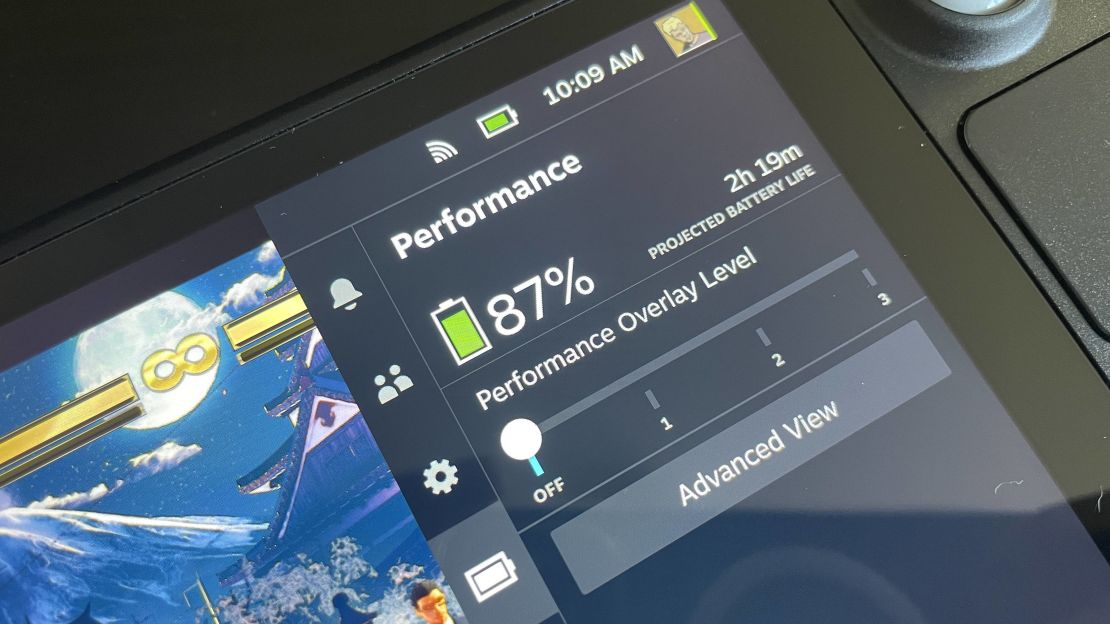
High-end titles like Elden Ring and Jedi: Fallen Order were especially hard on the Steam Deck’s battery, exhausting the system in roughly an hour and a half. We’ve generally found the Switch OLED to last a bit longer — an endless Super Smash Bros. Ultimate session ran for over four hours — but again, many Switch games aren’t as power-hungry as their PC counterparts.
Those who splurge on the newer Steam Deck OLED should expect slightly better battery life, as this version of the handheld is rated for three to 12 hours of run time. Still, these numbers are highly dependent on what you’re playing, and those running graphically rich triple-A games should plan to have a portable battery or power source nearby.
A focused games machine versus a true portable computer
The Switch OLED is cheaper than most versions of the Steam Deck, and with its handheld, tabletop and TV modes, offers more ways to easily game out of the box. But it’s important to keep in mind that while the Switch is a dedicated gaming device, the Steam Deck is a full-on computer.
Valve’s handheld runs a modified version of Linux, and when you switch it over to Desktop mode, you’ll be taken to a traditional, Windows-esque PC interface where you can browse the web and download any apps of your choosing. Using Linux certainly comes with a learning curve, but there is a handy built-in storefront that made it easy to get apps like Slack and Discord up and running. Once we paired a mouse and keyboard and propped the Steam Deck up on a stand, we suddenly had a mini computer that we could use to catch up with friends, stream shows on Netflix and even do some work in Google Docs (though we’d recommend connecting to a monitor for all of this — it’s hard to see all that on a 7-inch screen). If you have a bit of technical know-how, you can even install non-Steam games on the Deck, or install Windows to get access to even more apps and games.
By comparison, the Switch doesn’t do a whole lot outside of playing games. There are a handful of entertainment apps on the platform — including YouTube, Twitch, Hulu and Crunchyroll — but that’s about it. There’s no built-in browser for surfing the web, and unlike on Steam Deck, you’ll have to use a separate mobile app if you want to chat with your friends while you game.
Bottom line
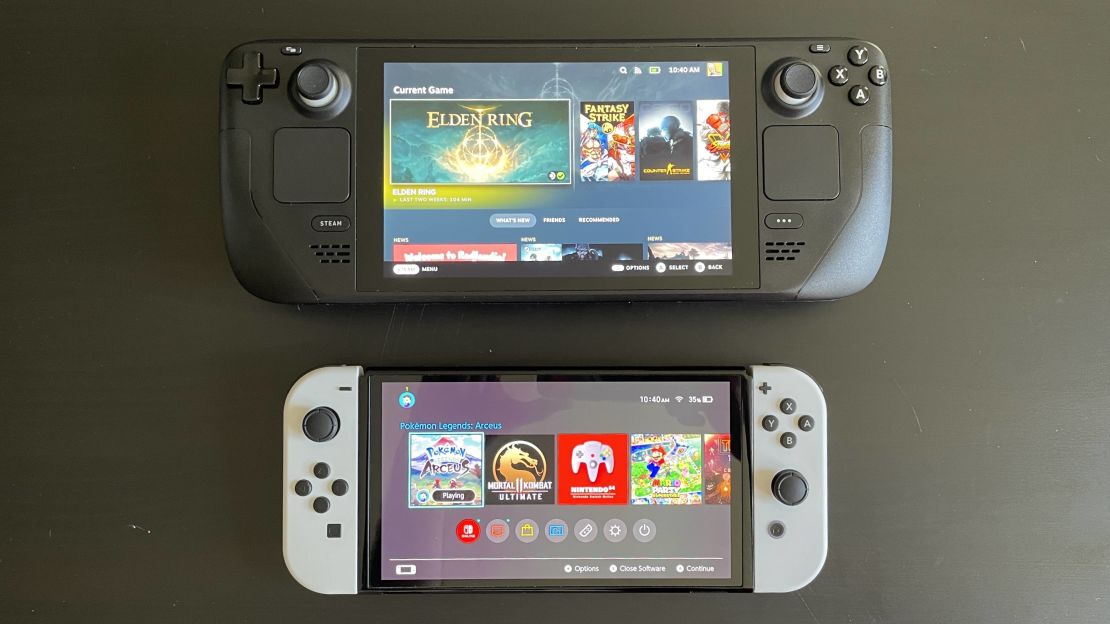
If you’re looking for something familiar, easy to use and family-friendly — or you just love Nintendo — you really can’t go wrong with the Switch OLED. It has a superb library of games that includes exclusives and lots of retro and indie stuff, and its versatile design makes it great for both playing on the go and in front of your TV. The system’s OLED display is truly gorgeous, and it’s cheaper than most Steam Deck models (and is often on sale).
But if you want a handheld that’s as robust and open-ended as a full-on PC, there’s a ton to love about the Steam Deck. It has a larger overall game library and just about the best performance you’ll find in a portable games machine. Its controls are more robust and customizable, and since it’s an actual computer, you’re free to connect any peripherals you like or even hook it up to a monitor and use it to do some work. And if you splurge on the Steam Deck OLED, you’ll get a screen that’s similarly as vibrant as the Switch OLED is complete with better battery life.

